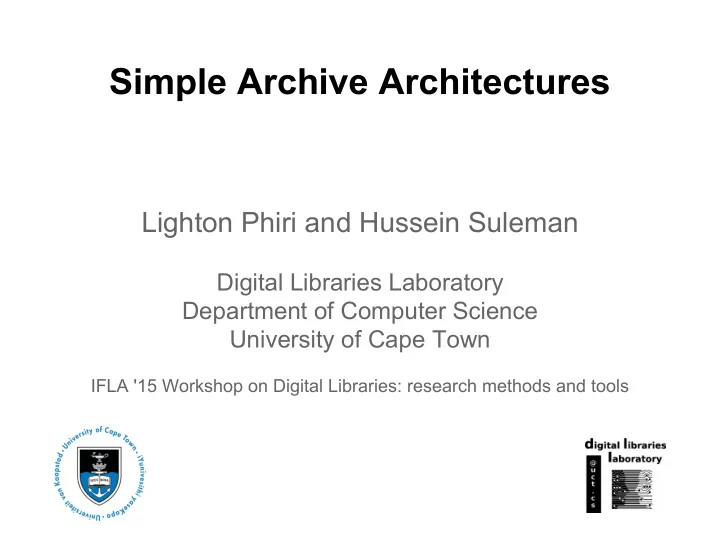

Simple Archive Architectures Lighton Phiri and Hussein Suleman Digital Libraries Laboratory Department of Computer Science University of Cape Town IFLA '15 Workshop on Digital Libraries: research methods and tools
www.martinwest.uct.ac.za 2
lloydbleekcollection.cs.uct.ac.za 3
Contextual Overview ● Problems and challenges ○ Preservation costs ○ Technical skills and expertise ○ Computing resources ● Proposed solution ○ Explicit simplicity and minimalism ○ Principled design of DL tools and services ● Motivation ○ Successes of minimalism---Project Gutenburg 4
Research goals ● Is it feasible to implement DLSes based on simple architectures? ○ How should simplicity for DLS storage and service architectures be defined? ■ Derivation of design principles ■ Simple repository prototype + case studies ○ What are the implications of simplifying DLS? ■ Developer user study ■ Performance evaluation ○ What are some of the comparative advantages and disadvantages of simple architectures? ■ DSpace 3.1 comparative evaluation 5
Claim #1: Simplicity for DL storage and services can be defined through derivation 6
Design Principles (1) ● Meta-analysis of popular software applications ○ 12 candidate tools were considered---even split between DL and non-DL tools ○ Tool attributes that potentially influenced design of tools identified ○ Pair-wise comparison done to assess most appropriate attributes ● Eight guiding design principles derived [1] ○ Applicable for simple and minimalistic architectures 7
Design Principles (2) ● Principles mapped to potential repository architectural design decisions ○ Applicable principles derived during mapping 8
Simple Repository Prototype ● File-based ○ Digital objects stored on OS ○ Hierarchical collection structure ● Metadata objects ○ DC plain text files ● Object organisation ○ Metadata stored along content ○ Nested objects 9
Case studies ● Two case studies involving two different collections ○ The Bleek and Lloyd Collection ■ Honours project: “Bonolo” [5] ○ SARU archaeological database ■ Honours project: “The School of Rock Art” [6] 10
“The Digital Bleek and Lloyd” ● 18,924 content objects with a total size of 6.2GB ● Two-level collection structure ○ Virtual content objects representing stories ● “Bonolo” [5] DLS implemented using repository sub-layer 11
“SARU Archaeological database” ● 72,333 content objects with a total size of 283GB ● Four-level collection structure ● “The School of Rock Art” [6] implemented using repository sub- layer 12
Claim #2: There are desirable features and advantages possessed by DL tools and services implemented using simple architectures 13
User Study (1) ● Developer-oriented study ○ Assess simplicity and flexibility of simple repository architecture ● Target population ○ 34 computer science honours students split into 12 groups of twos and threes ○ Basic developer skills and DL knowledge ● Approach ○ Participants tasked to build layered services using simple repository ○ Post-experiment survey 14
User Study (2) ● Wide variety of layered services ● Wide variety of programming languages used ● Choice of language not influenced by repository design; only 15% indicated that it did 15
User Study (3) ● Dublin Core XML- encoded files perceived simple& easy to work with ○ 69% and 61% respectively ● Repository perceived simple but not easily understandable ○ 62% and 46% respectively 16
User Study (4) ● Simplicity resulted in more understandable repository layer ○ Most participants found Dublin Core XML- encoded metadata files easy and simple to work with ○ Most participants found hierarchical structure simple but not easily understandable ● Flexibility of interaction with repository layer unaffected by simplicity ○ No influence on programming languages 17
Performance Evaluation (1) ● Assess and benchmark performance relative to collection size ○ Typical DL service aspects evaluated. Ingestions, search, OAI-PMH data provider and feed provider ○ Log analysis of production repository informed aspects ● Comparative assessment with DSpace 3.1 ● Experimental design ○ Metrics---Response time ○ Factors---Collection size and structure 18
Performance Evaluation (2) ● Three datasets with 15 linearly increasing workloads; data from NDLTD Union Catalog ○ One-, two- and three-level collection structures ○ Varying objects in different collection structures 19
Performance Evaluation (3) ● Performance within acceptable limits for medium-sized collections ● Collections > 12,800 objects affected ● Information-discovery services---feed, full- text search and OAI- PMH data provider--- affected 20
Performance Evaluation (4) ● Performance benchmarking ○ Performance within acceptable limits for medium sized collections ○ Performance degradation beyond 12 800 objects ○ Performance degradation adversely affects information discovery services; ingestion process unaffected by collection scale ● Comparison with DSpace 3.1 ○ Ingestion performance outperformed DSpace 3.1 ○ Information discovery services outperformed by DSpace 3.1 21
Conclusions ● Principled DL design approach undertaken ● Feasibility of simple DL architectures ● Minimalism does not affect flexibility and extensibility of DL tools and services ● Performance acceptable for small- and medium-sized collection ● Comparable results with well-established solutions 22
Bibliography [1] Lighton Phiri and Hussein Suleman. In Search of Simplicity: Redesigning the Digital Bleek and Lloyd . DESIDOC ‘12 32(4): 306–312, 2012. [2] Lighton Phiri et al. Bonolo: A General Digital Library System for File-based Collections . ICADL ‘12 7634:49–58, 2012. [3] Lighton Phiri and Hussein Suleman. Flexible Design for Simple Digital Library Tools and Services . SAICSIT ‘13 160–169, 2013 [4] Lighton Phiri and Hussein Suleman. Managing cultural heritage: information systems architecture . Facet Publishing 13–134, 2015 [5] Stuart Hammar and Miles Robinson. Bonolo Project URL: http: //goo.gl/EtblcR [6] Kaitlyn Crawford et al. The School of Rock Art . URL: http://goo. gl/U092EH 23
Questions? Additional information http://dl.cs.uct.ac.za
Recommend
More recommend